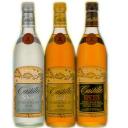 Rum is one of the more distinctive alcoholic beverages because of its variety of flavors, and rum brands such as Bacardi are some of the more popular ones in the liquor store. It’s a big product in the Caribbean where most of it is made and plays a role in the culture of the West Indies.
Rum is one of the more distinctive alcoholic beverages because of its variety of flavors, and rum brands such as Bacardi are some of the more popular ones in the liquor store. It’s a big product in the Caribbean where most of it is made and plays a role in the culture of the West Indies.
It’s even found in the history books because of the part it played in the English slave trade. It was also one of the more popular items with the pirates of the 17th century, who frequented the Caribbean and the Indies regions.
Manufacturing Rum
 It’s quite difficult to manufacture rum on your own, especially if you don’t find yourself the owner of a distillery or some other sort of processing facility. Developing your own blend and mix for rum could also take a lot of time because of the number of factors involved in creating the final flavor of the rum. It is made even more difficult by the fact that there is no set recipe or specifications for rum and that the institutions that make rum predictably keep their methods a tightly guarded secret.
It’s quite difficult to manufacture rum on your own, especially if you don’t find yourself the owner of a distillery or some other sort of processing facility. Developing your own blend and mix for rum could also take a lot of time because of the number of factors involved in creating the final flavor of the rum. It is made even more difficult by the fact that there is no set recipe or specifications for rum and that the institutions that make rum predictably keep their methods a tightly guarded secret.
Making Rum – An Overview
Initially, rum was made from molasses, one of the substances that get left behind when sugar is made or processed. As rum-making developed, it has also become common to add other byproducts from the processing of cane sugar.
Once the molasses and other ingredients have been procured, the fermentation process is begun, commonly with the use of yeast. While wild yeasts can be used, many manufacturers prefer to use a particular strain to make the results more predictable. The yeast used is one of the major factors in determining the taste in the rum because a longer fermentation time makes for rum with a more full-bodied taste.
The fermented product is then distilled with the use of stills. There are two kinds of stills that can be used in producing rum – pot stills and column stills. The type used is another determining factor in the taste. Pot stills tend to leave behind more impurities in the distilled product, giving it a richer flavor.
The distilled liquid is then put in casks to age. Using different types of casks will result in different flavors, ranging from new casks for lighter flavors to heavily charred casks for richer tastes. The aging process can take anywhere from two to seven years. Many factors can affect the aging process, such as the climate and other additives (like caramel) that were used in the rum.
If you’re interested in and serious about making your own rum, be prepared for a major investment in terms of time and finances. You’ll find that manufacturing rum will be difficult but can also be very rewarding.